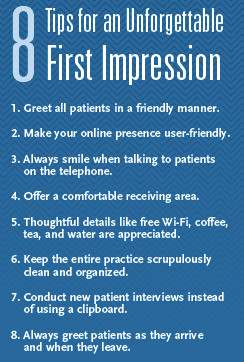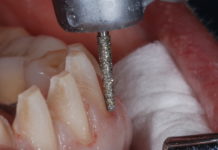
Don’t Ignore the Details that Can Differentiate Your Practice.
You’ve probably heard the saying, “You never get a second chance to make a first impression.” When it comes to a dental practice, a visitor’s first impression often determines whether or not that person becomes your patient. New visitors don’t know you or your practice. Everything about the initial contact should be positive so they keep coming back.
Dr. Dick Barnes, founder of Arrowhead Dental Laboratory, said, “People do business with people they trust.” In other words, people should be given every opportunity to have a good impression of you and your practice.
In his 1972 book Contact: The First Four Minutes, author Leonard Zunin, M.D., suggests that in only four minutes, people form a favorable or unfavorable impression of you. According to Zunin, with a good impression, people are willing to continue the relationship. However, with a bad impression, you’re out. All team members should make the dental practice experience unforgettable for patients.
Stories From the Field
For years, I have traveled across the country visiting dental practices as part of my professional responsibilities. Every time I visit a dental practice, I imagine what the experience might be like for new patients. If someone visits a practice and is greeted by a team member with a negative or uninterested demeanor, it can cause the visitor to become somewhat guarded. However, if an accommodating and friendly person greets the visitor, the overall experience is usually very positive. An overall inviting and positive environment helps to promote business and encourages patient retention.
Remember that new patients are not your patients yet. New patients need a chance to get to know your practice. The first interactions are so important—whether they occur over the phone, online, or in person.

The Online Visitor
More and more often, patients schedule dental appointments and research a dental practice online. Sometimes there’s no human interaction until the first appointment. Many dental websites list a plethora of the products that they offer, which can confuse and even scare patients away. Too much technical information can be overwhelming for new patients. A dental website should offer easy-to-understand information in a clear and comforting manner.
Keep the website design simple and inviting. Make sure the dental practice’s hours of operation are clearly visible on the website—it’s often the first thing patients are looking for. It’s also a good idea to include a nice photo of the doctor in order to provide a familiar face for patients. Make sure the dental practice address is also clearly visible so that patients can use that information to navigate to the office easily.
The Telephone Caller
After visiting a website, a dental patient’s next impression of a practice is often via the telephone. A good telephone conversation should leave the caller feeling confident that they called the best practice. On the phone, team members should use a pleasant voice when greeting all callers. Tawana Coleman, the former instructor for the Total Team Training seminar, said, “Even on the telephone, patients can always tell when you’re smiling and can always tell when you’re frowning. So make it a smile.” Before answering the phone, team members should take a moment to think about their greeting and smile before speaking to the caller. Every phone call is very important!
The Office Visit
It’s easy to attract new patients and maintain current patients simply by being pleasant and accommodating. However, this simple principle is sometimes harder for team members to execute than you might think—usually because they underestimate its importance.
Positive first impressions aren’t important just for new visitors. For existing patients, a positive experience at the start of an appointment provides a sense of reassurance, and confirms that they will have a good experience during the remainder of the visit.
I’ve worked with offices where the dentist and team members suggest that the only thing that matters is the dentistry—they believe that small pleasantries from team members don’t make a difference.
Don’t get me wrong, the dentistry is extremely important, but developing relationships is just as important. Developing good relationships with patients ensures that they return so that the dentistry can be done. They will be lifetime patients.
If dental practices don’t cultivate good relationships with their patients, the patients will not be invested in the relationship and may eventually go somewhere else.
To build relationships with patients, become friendly with them. If a patient comes in close to his or her birthday, ask team members to wish them a happy birthday. Similarly, wish patients happy holidays during the holiday season. And offer compliments to patients—little things like this help build strong relationships.
When I visit dental offices, team members often ask me what they can do to improve the patient experience. Often the answer is simple: make the time spent in the dental practice a positive experience for the patients from start to finish.
In order to ensure a positive experience for patients, team members should leave their personal problems at the door. My son is a chef and he often says, “When you’re working and the stove is on fire, none of the customers should know.” His statement underscores the importance of keeping the customer experience positive no matter what kind of mayhem may be going on behind the scenes.
This principle is even truer for dentistry because many patients are apprehensive in a dental environment. Since they’re already a bit nervous about potential discomfort, team members must work extra hard to convey a sense of peace. For nervous patients, the behavior of the team members working at the front desk is critical for a pleasant and relaxing experience.

A Welcoming Atmosphere
William Shakespeare said, “All the world’s a stage,” and it is true! Team members are “on stage” the minute a visitor walks into the office. The front desk associate must be relaxed, otherwise he or she will unnerve the patient.
I have been seated in the reception area when something tense is happening behind the front desk. I immediately noticed that the other patients in the receiving room were visibly uncomfortable.
On the other hand, when an office is calm, I can look around and see patients who are likewise calm (and usually smiling). No matter how busy you are, it’s important to project a calm and inviting atmosphere. Sometimes team members have to just pretend that everything is calm, but even if they are pretending, the positive effect is the same.
The Receiving Area
In a dental office, the name you use for your front area is important. A lot of offices use the term “waiting room.” But think for a moment about the connotation of such a label. If it’s called a “waiting room,” it means your patients will be waiting, and no one likes to wait. Waiting automatically has a negative connotation. Instead, call it a receiving room. This can subliminally help change a patient’s perception. A receiving room is where patients are welcomed and greeted.
Some teams members assume that their office décor should be modern and in the current fashion in order to project the best impression. However, nice décor doesn’t always translate into a good experience. You can go to the “Taj Mahal” of offices and still have a bad experience; or you can go to a very humble office and have a wonderful experience. The important thing is the experience.
Make the receiving area cozy and inviting, and offer comfortable seating. Also consider offering Wi-Fi and water or some teas and coffees. Keep the entire office very clean. Pay attention to details. Old, dusty plants or décor can suggest to the patient that things are not being taken care of and can give a bad impression.
If there’s not a restroom in the receiving area, make sure to tell patients where the restrooms are located when they check in. Make sure patients know that they are in good hands when they sit in the reception area. I have visited dental offices where the receiving room was very humble, but the experience was remarkable because the team members took care of every detail.
When you visit a dental office that is organized—meaning all the magazines are arranged in an orderly fashion, the chairs are in order, there’s no clutter, and people are calm—patients have a good experience.

Eliminate Barriers
It’s just a personal observation, but I have noticed that some dental offices have a window separating the front desk from the reception area. The team members sit behind the window, and they slide the glass open to talk to patients. The sliding glass window creates a physical barrier between team members and patients. Most patients prefer a feeling of accessibility where they can reach the team members and doctor if they need anything.
New Patient Interviews
A new patient interview is an important part of making a positive impression on patients. When visiting a new dental office, many patients expect to be handed a clipboard to fill out their health information on. Instead of giving patients a clipboard, ask the patient to discuss their health concerns in a short, private interview. A new patient interview immediately makes patients feel important and signals that the office cares about their health.
The new patient interview should make the patient feel comfortable discussing his or her health concerns, and welcome the patient to a place of trust. In this short conversation (usually no more than 10 minutes), you discover the patient’s needs and wants with regard to his or her dental health. The interview immediately differentiates your dental practice from others.
After a new patient interview, I’ve heard patients say, “I have never had that experience before!” It makes the patient feel special. With the new patient interview, patients feel like human beings instead of just another statistic filling out a form. When done correctly, the new patient interview is a caring discussion with team members who are genuinely interested in the health concerns of the patient.
Words Matter
I’ve already described the psychological difference between the terms “waiting room” and “receiving area.” But the name of your receiving area isn’t the only term that matters. The words that team members use are important. Sometimes team members forget to say goodbye to patients, and those patients are left wondering if they are finished. The salutations used when patients arrive and depart should always be very well defined.
When an office is a little behind schedule, I’ve heard team members tell patients, “We’re running a little late. We’ll be right with you.” Instead of using such words, acknowledge the patient and explain that the doctor knows he or she is waiting. Say, “Mrs. Jones, Dr. Smith knows you’re here. He has a tight schedule today, but our team will be with you momentarily.”
The phrase “I’ll be right with you” can mean many things. It can be 5 minutes or 30 minutes, but the patient is assured that the doctor is aware of the situation and will be with him or her soon. If a team member simply asserts, “The doctor is running behind,” patients immediately assume the worst. They might think, “He’s going to rush though my appointment and it will hurt!” Or, “He’s not going to give me adequate time since he’s running late.” When the office is behind schedule, the words used to communicate with patients can help or hurt the situation.
To convey a positive message, praise a patient who arrives on time. If a patient arrives a bit late, continue the positive message. Say, “I’m glad you made it. We can still see you. I will let the team know that you are here.” Use neutral words. For example, instead of saying, “the doctor will be with you right away,” say, “our team will be with you momentarily.” “Momentarily” is a neutral, soothing word that can have many meanings.
Make sure that when a financial team member discusses payment with patients, it’s in a private or at least semi-private area. Patients can be very uncomfortable talking about payment when other people are nearby. When patients are uncomfortable, they want to escape the situation, and this can have an negative effect on whether or not they agree to treatment in subsequent appointments.
Saying Goodbye
In addition to first impressions, final impressions are important. After an exam has ended, rather than letting patients figure out they are done, always communicate expectations to them. Team members should let patients know whether they need to visit with a financial coordinator or a scheduling coordinator. And of course, team members should explain where patients can exit the building, and offer heartfelt thanks for the visit.
Keep an eye on all aspects of the patient’s experience and it will be positive from start to finish. The difference between a positive and negative experience is in all the details.









